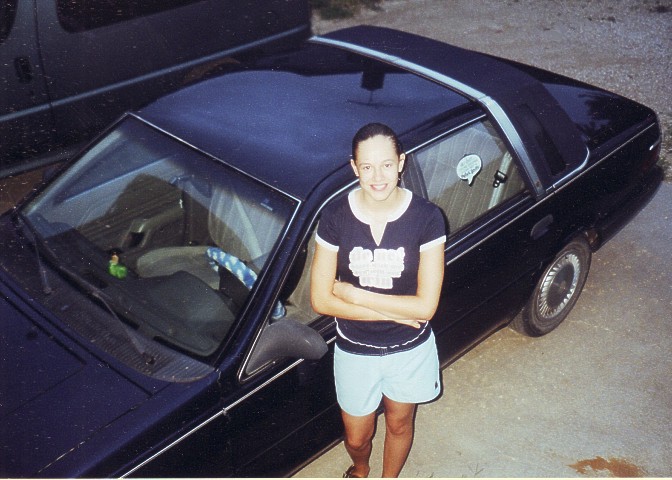Kansas Snapshots by Gloria Freeland - March 25, 2016
10,000 steps, 3,000 miles and 8 glasses of water
With Spring Break at the university just a few days away, I suggested to husband Art that we go visit our friend Jo in
southwestern Wisconsin. Jo said she was looking forward to it, but shortly after, my car gave a "10% Oil Life Remaining"
message. Art said his was nearing the change time as well. But when we called our usual change place, they were booked
until the day we were to leave.
I was concerned, but my engineer husband wasn't concerned at all.
"Your car computer says it has about 10 percent oil life left, indicating that we could go about 750 miles. Then when
you add the approximately 2,000 margin built in, our 1,500 mile trip would be no trouble at all," he explained.
His car indicated 21%, so we used it. Still, I've always heard that you should change oil every 3,000 miles. Every time
I get the oil changed in one of my vehicles, the guys at the shop put a sticker on the upper left portion of my windshield
to remind me that I should get it changed again after 3,000 miles or three months, whichever comes sooner.
"That's a good idea if your pocket book is feeling too heavy," Art said laughing.
Doing some research, I noted that the California recycling program urges the state's residents to check the
recommended oil change interval for their car in their owners' manuals:
The old standard of 3,000 miles is woefully out of date and no longer applies to most cars. Many cars, even older
models, can be driven up to 5,000, 7,500, 10,000, and even 15,000 miles before needing an oil change.
Edmunds, Inc., an authority in all matters automobile, agrees. Its website says:
After interviews with oil experts, mechanics and automakers, one thing is clear: The 3,000-mile oil change is a myth
that should be laid to rest. Failing to heed the service interval in your owner's manual wastes oil and money, while
compounding the environmental impact of illicit waste-oil dumping.
That made me start questioning some of those "common knowledge" pieces of advice that have entered our collective
consciousness such as the one about how we all should be drinking eight 8-ounce glasses of water every day. This idea is
especially promoted by the bottled water industry. It wasn't hard finding reputable sources that debunk this myth. But
it lingers on, much the way until the end of her life, Mom would say sitting in a draft caused a person to "catch a cold."
Some feel that the origin of this 8-glasses myth was a 1945 study authored by the Food and Nutrition Board of the
National Research Council.
A suitable allowance of water for adults is 2.5 liters daily in most instances.
Apparently the following sentence was ignored:
Most of this quantity is contained in prepared foods.
In other words, unless we limit ourselves to only eating crackers and dry bread all day, our food is bringing along
enough water to cover most of what we need.
While we were at Jo's, she mentioned she was having trouble with the Fitbit she'd recently been given as a gift. Art
took care of that, but then looked up the basis for the minimum of 10,000 steps per day it promotes. He found some
information on the livescience.com website. According to Catrine Tudor-Locke of the Walking Behavior Laboratory at
Pennington Biomedical Research Center in Baton Rouge, Louisiana, pedometers in Japan in the 1960s were sold under the
name "manpo-kei," which translates to "10,000 steps meter."
While almost everyone agrees that more activity translates to lower blood pressure, better cardiac health, stronger
bones and perhaps less stress, losing weight is often promoted, but is unlikely to be one of the benefits. According to
Aseem Malhotra, a cardiologist and consultant clinical associate to the United Kingdom's Academy of Medical Royal
Colleges, sales of fitness trackers (including Fitbits) are expected to triple within the next five years. Yet obesity
continues to be a problem around the world. He says:
That's not a fluke. Our waistlines aren't expanding because people aren't exercising intelligently or vigorously
enough. You don't need a new personal trainer, another Insanity workout video or a more aggressive CrossFit regimen. What
you need is the truth, and here it is: Exercise - no matter how many gym memberships you buy or how often you wear your
Fitbit - won't make you lose weight. The idea that our obesity epidemic is caused by sedentary lifestyles has spread
widely over the past few decades, spurring a multibillion-dollar industry that pitches gadgets and gimmicks promising to
walk, run and kickbox you to a slim figure. But those pitches are based on a myth. Physical activity has a multitude of
health benefits - it reduces the risk of heart disease, Type 2 diabetes, high blood pressure and possibly even cancer,
but weight loss is not one of them.
But if we take in more calories, can't we counter the effect by exercising more? Yes, but we'd have to exercise A LOT!
The problem is that vigorous exercise burns far fewer calories than most believe. As Aaron E. Carroll, the New York Times
health writer notes, it takes 30 minutes of continuous jogging or swimming to burn off the calories in two "small"
McDonald's soft drinks.
So, 3,000 miles, eight glasses of water and 10,000 steps are nice easy numbers to remember. But it's just as important
to remember that they might be promoted by companies wanting us to buy more of their products.
